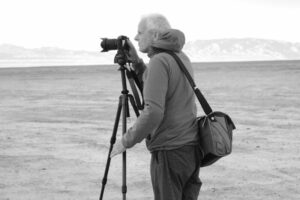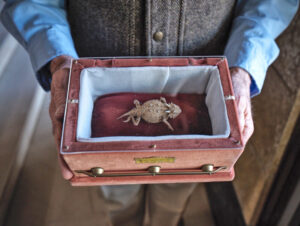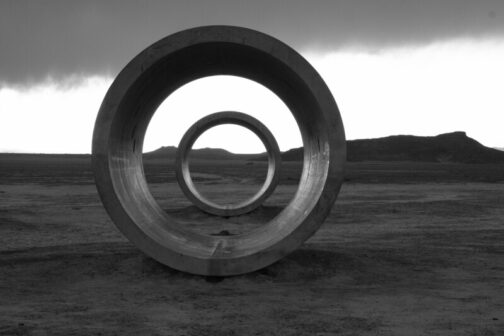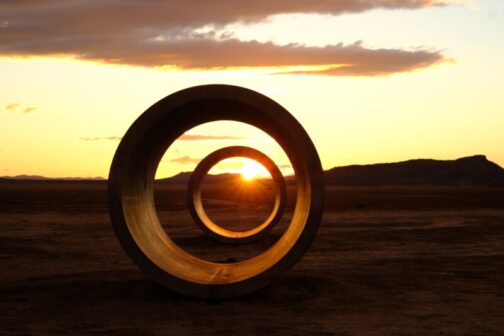Back in 1974 I flew across the Great Salt Lake to a remote corner of the state aboard a Cessna piloted by one Sandy Gilmour—known to his colleagues at KUTV as “Sandy Glamour.” My job was to film Sandy doing a stand-up in front of what looked to be four giant concrete culverts being hoisted from flatbed trucks by a crew of bemused heavy equipment operators. Directing the placement of the 18-foot-long tubes was an assuming lady whose name I learned was Nancy Holt, widow of Robert Smithson, creator of the Spiral Jetty on the opposite side of the lake. Besides Sandy, myself and fellow cameraman Sid Crandall, there was no press on scene, which is just how earth artists like Smithson and Holt prefer to operate—quietly and sans fanfare. Ideally, one will just happen upon an earth art installation, and without benefit of a guide or interpretive kiosk, be forced to make of it whatever one will.

I haven’t returned to the Sun Tunnels in years; however, last weekend a photographer friend was in town and wanted to see them. I volunteered to drive, provided Steve Plattner pay for the gas. Plattner lives in Cincinnati, but travels extensively in search of offbeat roadside attractions and little known ephemera such as the celebrated non-jumping horned toad of Eastland County, Texas, which he had photographed as it lay in state only days before.

The Sun Tunnels aren’t that far from Salt Lake City as the crow (or Cessna) flies; however, it’s a long drive to get there. We spent the first night in the border town of Wendover, continuing west on Interstate 80 the following day to the semi-ghost town of Oasis. From Oasis we headed northeast on Nevada SR 233, to Montello, a grim outpost which, from appearances, hasn’t yet gotten the memo that Donald Trump lost the 2020 election. We did not stop.
By and by we exited the pavement onto a gravel road that leads to Lucin, once a watering hole along the nation’s first transcontinental railroad. The mainline has since been relocated, and today Lucin is naught but a historic marker and a struggling grove of cottonwood trees. Beyond Lucin, the graded road deteriorates to teeth-rattling washboard. Wondering where we might spend the night, we looked for signs of a rumored BLM campground; not finding it, we opted to camp within walking distance of the tunnels. There we pitched our tent, assembled our REI camp chairs and rolled out our sleeping bags.

Did I mention that the weather was terrible? The skies were dark, with storm cells scudding this way and that. Hailstones pelted the roof and walls of our tent, which flapped wildly in gale force winds. Reportedly, an army of voracious Mormon crickets from Pershing County was marching toward our location. Yet we were determined to stay put–in hopes of catching a sunset, which at this time of year would be neatly framed between the two east and west-aligned tunnels. However, our chances did not look good as the sun remained hidden behind a leaden overcast. In my viewfinder the tunnels registered eighteen percent gray.
But then something miraculous happened. As the setting sun dipped beneath the cloud curtain, things suddenly went from gray to gold. The wind died down; our shutters clicked, and there were smiles all around. Like Druids at Stonehenge, we did a happy dance, and for one bright, shining moment, all previous hardships were forgotten.

